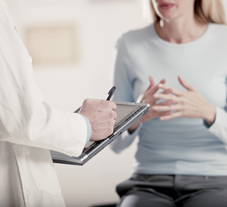
CPAP, BiPAP, and AutoPAP (sometimes called APAP) are all types of PAP (Positive Airway Pressure) Therapy. The most common types of PAP are discussed below, but in general, PAP Therapy is an alarm clock-sized machine that blows positive pressure into the back of the throat by way of a mask worn over the nose (or sometimes both the nose and mouth). This pressure supports the airway and helps keep it open thereby preventing Obstructive Sleep Apnea (OSA). Depending on the type of PAP, pressure settings may be adjusted during a Sleep Study. A doctor's order with prescribed PAP settings is required for its use at home.
Types of PAP Therapy
Click on the type of PAP therapy to learn more:
Continuous Positive Airway Pressure (CPAP)
CPAP is the most common type of PAP Therapy. The "C" stands for Continuous and refers to the fact that the machine has one pressure setting regardless of whether the individual is breathing in (inhalation) or breathing out (exhalation). Pressure settings may range greatly, and is typically determined during a Sleep Study. Top »
Bilevel Positive Airway Pressure (BiPAP)
As the acronym "Bi" suggests, BiPAP uses two pressure settings; a higher pressure for inhalation and a lower pressure at exhalation. Since most people aren't bothered by PAP during inhalation, BiPAP can feel more comfortable for those unable to tolerate CPAP. Another plus to BiPAP is that clinicians have two pressure settings to adjust; this can have advantages for patients diagnosed with OSA. Like CPAP, appropriate pressure settings for BiPAP are determined during a Sleep Study. Before BiPAP can be tested, however, CPAP must first be tried and found to be ineffective or not tolerated. Top »
AutoPAP (APAP)
AutoPAP is similar to CPAP, but instead of the machine being set to one pressure setting, AutoPAP is set to use a range of pressures. AutoPAP has sophisticated technology that can detect when the wearer is having OSA and can then ramp up the pressure to treat the apnea. The advantage of AutoPAP is it can ramp the pressures as needed, generally spending more time in the lower pressure ranges and thereby making it more comfortable. AutoPAP ranges can be determined from a Sleep Study, but it is not required. Top »
Other Types of PAP
These are the most common types of PAP used to treat OSA, but there are other PAP therapies (and more being developed all the time) that target the treatment of complex sleep apnea and other breathing disorders. To understand or learn about these specialize machines please feel free to call the Sleep Disorders Center at (317) 745-3680 and talk to our knowledgeable staff. Top »
Call to Schedule
If you have symptoms of a sleep problem, talk with your doctor or call (317) 745-3680 for more information or to make an appointment with a Sleep Specialist.
Forms & Instructions
Resources
How to Get PAP Support
For many, PAP Therapy is a life changing experience which finally allows a person to get restorative sleep. For some, however, getting used to PAP takes time, patience—and sometimes a coach. If you're struggling with wearing your PAP, let us help. Our PAP Clinic staff are certified Sleep Educators, specifically trained in PAP troubleshooting and adjusting, mask issues, education, and coaching. Let us develop a care plan specifically designed to address those problems which keep you from benefitting from PAP Therapy. If your employment or insurance requires PAP Therapy compliance, we can help you meet those requirements.
PAP Clinic support is a covered service of many insurance plans. A doctor's order is needed for our PAP Clinic. Call (317) 745-3680 to schedule an appointment with our PAP Clinic, or for help arranging a referral.